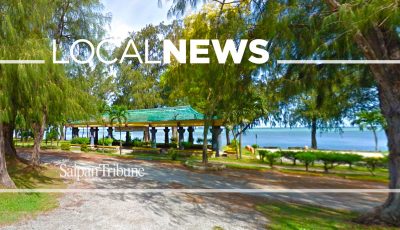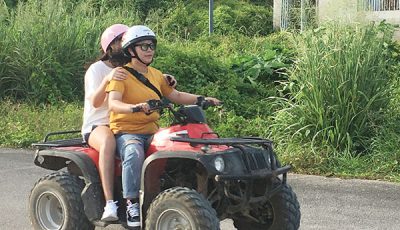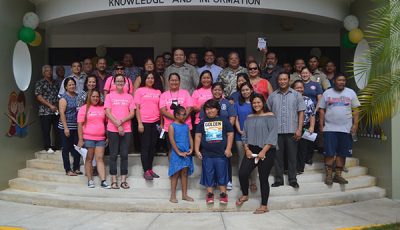Tinian: A place of eerie beauty
- This bell tower is what remains of the old San Jose Catholic Church that was damaged during World War II. (Jon Perez)
- A bird made this rocky portion of Tinian’s Suicide Cliff its nesting ground. (Jon Perez)
- Water blasts from the Blow Hole as strong waves crash on the undersea caves. (Jon Perez)
- Air raid shelters provided safe haven for Japanese soldiers from the bombardment of U.S. forces. (Jon Perez)
- One of the two atomic bomb pits were the weapons were loaded to B-29 Superfortresses and later dropped in the Japanese cities of Hiroshima and Nagasaki. (Jon Perez)
SAN JOSE, Tinian—Tinian, Saipan’s next-door neighbor, is a place of raw beauty—a haven for those who want to go trekking. It is also a treasure throve of history, eerie sites that serve as a reminder of the horrors of World War II.
One can go take on the different trails—either by foot, mountain bike, or ATV— or swim at the crystal-clear waters of various beaches that can be found around the 39-square-mile island. Go snorkeling or diving and see different types of fish.
Above water, Tinian is also abundant in plants and trees but sadly the hotter climate we are experiencing due to the El Niño—that has also brought droughts in the Marshall Islands and Palau—has caused a portion of the land where vegetation grows to turn brown due to lack of rain.
Be also on the look out for the Tinian Monarch or the Tinian Flycatcher—but not to be confused with the monarch butterfly—an endemic species of bird that almost went extinct after Tinian’s forests were either turned into agricultural land or for military facilities during World War II.
Sun and sea
One can also swim in a number of beaches around the island and cool off and enjoy the turquoise blue waters of the Pacific.
Kammer, Tachogna, and Taga beaches are among them and are more accessible as it is near the area where the San Jose Fiesta and Tinian Hot Pepper festivals are held. Tachogna is also a stone’s throw away and has a pavilion and benches for public use.
Local residents and families enjoy weekend barbecues especially at Tachogna, which is also a perfect spot for snorkeling and swim with schools of fishes. Water sports also abound where you could rent jet skis and ride a banana boat.
If you want a sort of secluded place, you could check out Chulu Beach and try spearfishing or visit the Blow Hole and get blasted by waves that shoot up from a vertical shaft. You must be cautious while going to the Blow Hole as the path has sharp rocks and on your right side is a restricted area that still has live World War II bombs and ordnances.
A touch of history
The House of Taga and the Unai Dangkulo Petroglyph Site are among those included on the National Register of Historic Places list in the CNMI. They are remnants of the Chamorro people who lived there even before the European colonizers discovered the island chain.
The House of Taga is a historical site where latte stones—quarried limestone—were used by ancient Chamorros as stone pillars for their homes. The site was believed to be the original home of Chief Taga.
Tinian is also littered with structures and places that played an important role in ending the Second World War. Cannons used by Japanese soldiers, an amphibious vehicle, Ushi Point in the Northfield area where Allied troops landed to begin the liberation of the island.
Some of the sites give you an eerie feeling knowing that these have been part of one of the bloodiest battles during World War II where thousands died.
You can find the atomic bomb pits where the first ever weapon of mass destruction was loaded to two B-29 Superfortresses and separately dropped in the Japanese cities of Hiroshima and Nagasaki—“Little Boy” on Enola Gay on Aug. 6, 1945 and “Fat Man” on Bockscar three days later. The bombs where used to force Japan to surrender and cost thousands of lives.
The bomb pits are located in the old North Field where two air raid shelters, which still have bullet and mortar marks, can also be seen.
One can’t help but wonder how the Japanese soldiers felt knowing that U.S. soldiers are right at their doorstep with death or surrender their only options.































